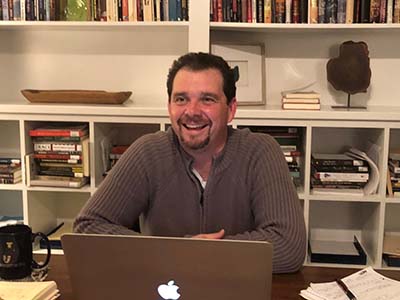History Peeps: Dr. Carlos K. Blanton, Department Chair

We all want a place where we belong, where we feel welcomed and valued. Dr. Carlos Blanton found his when he arrived at Texas A&M University as a junior faculty member in 2001 and discovered his “peeps.” For twenty years he has grown alongside them through good times and bad. Last year, six months before the Covid-19 pandemic hit, he stepped into the role of leader on the brink of a whirlwind that has since demanded constant vigilance—and yet he still makes time for students and colleagues to drop in for a chat on work, life, or the latest feats of his beloved Dallas Cowboys. At the Department’s yearly Thanksgiving luncheon, Carlos Blanton always seems to be at the liveliest table, sharing stories and laughs with anyone who takes a seat.
With a Ph.D. in history from Rice, Dr. Blanton is a passionate advocate for better representation of the authentic American southwest. He has published books on the “strange career” of bilingual education and the “long fight” for Mexican American integration. Within the Department, he helped develop the Latinx/Mexican American research cluster alongside Professors Armando Alonzo and Lisa Ramos. It has since grown to include Professors Sonia Hernandez, Felipe Hinojosa, and Sarah McNamara. His own scholarship has been recognized in the intersecting fields of education, Chicana/Chicano history, and American studies.
To what historical figure would Dr. Blanton like to say “Howdy,” given the chance? He finds it impossible to pick just one—and since he is Chair, he gets three! He would most like to meet Presidents Abraham Lincoln, Franklin Delano Roosevelt, and Lyndon Baines Johnson. All three led the United States at times of massive uncertainty, but each was a beacon of hope who moved us towards a greater sense of human equality despite their flaws. Like them, Dr. Blanton encourages us to strive towards our highest ideals as scholars while finding and supporting our “peeps” to maintain the welcoming community at Texas A&M.
(By Kaitlyn Ross ’23)
